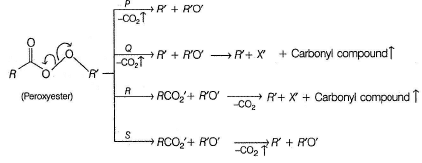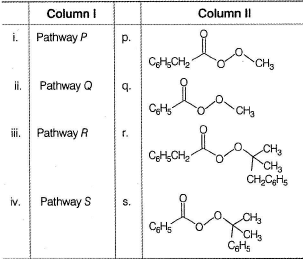Retro (Past 13 Year) IIT-JEE Advanced (Carboxylic Acids And Acid Derivatives) - JEE MCQ
9 Questions MCQ Test - Retro (Past 13 Year) IIT-JEE Advanced (Carboxylic Acids And Acid Derivatives)
Different possible thermal decomposition pathways for peroxyesters are shown below. Match each pathway from Column I with an appropriate structure from Column II and select the correct answer using the code given below the lists.



The total number of carboxylic acid groups in the product P is

(2013Adv., integer Type)
| 1 Crore+ students have signed up on EduRev. Have you? Download the App |
The compound that does not liberate CO2, on treatment with aqueous sodium bicarbonate solution, is
(2013 Adv.,Only One Option Correct Type)
Passage for Q. Nos. (4-5)
P and Q are isomers of dicarboxylic acid C4H4O4. Both decolourise Br2 / H2O. On heating, P forms the cyclic anhydride.
Upon treatment with dilute alkaline KMnO4. P as well as Q could produce one or more than one form S, Tand U.
Q.
Compounds formed from P and Q respectively are,
P and Q are isomers of dicarboxylic acid C4H4O4. Both decolourise Br2 / H2O. On heating, P forms the cyclic anhydride.
Upon treatment with dilute alkaline KMnO4. P as well as Q could produce one or more than one form S, Tand U.
Q.
In the following reaction sequences V and W respectively are
The compound that undergoes decarboxylation most readily under mild condition is
(2012,Only One Option Correct Type)
With reference to the scheme given, which of the given statement (s) about T U, V and W is (are) correct ?
(2012, One or More than One Options Correct Type)
Identify the binary mixture(s) that can be separated into individual compounds, by differential extraction, as shown in the given scheme.
(2012, One or More than One Options Correct Type)
In the following reaction sequence, the correct structures of E, F and G are
(2008,Only One Option Correct Type)

















